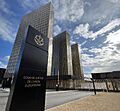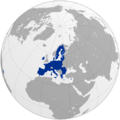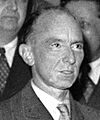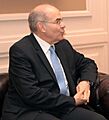European Court of Justice facts for kids
Quick facts for kids Court of Justice |
|
|---|---|
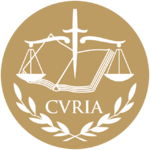
Emblem of the Court of Justice of the European Union
|
|
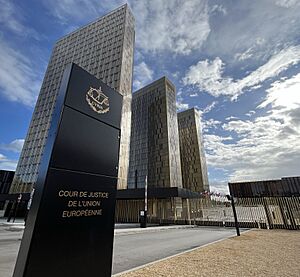
Court of Justice headquarters
|
|
| Established | 1952 |
| Jurisdiction | European Union and Northern Ireland |
| Location | Palais de la Cour de Justice, Kirchberg, Luxembourg City, Luxembourg |
| Composition method | Appointed by the representatives of the governments of the member states |
| Authorized by | Treaties of the European Union |
| Appeals from | General Court (European Union) |
| Number of positions |
|
| President | |
| Currently | Koen Lenaerts |
| Since | 8 October 2015 |
| Vice-President | |
| Currently | Rosario Silva de Lapuerta |
| Since | 9 October 2018 |
| Registrar | |
| Currently | Alfredo Calot Escobar |
| Since | 7 October 2010 |
| Division map | |
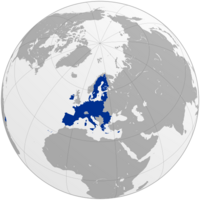 |
|
The European Court of Justice (ECJ) is a very important court for the European Union. It is like the highest court for anything to do with EU law. Its main job is to make sure that EU laws are understood and used in the same way in all EU countries.
The Court started in 1952 and is located in Luxembourg City. It has one judge from each EU country, which means 28 judges right now. These judges usually work in smaller groups of three, five, or fifteen. The current head of the Court is President Koen Lenaerts, who has been in charge since 2015.
The ECJ is the top court for EU laws, but not for the laws of individual countries. You cannot appeal a national court's decision directly to the ECJ. Instead, national courts can ask the ECJ questions about how to understand EU law. The ECJ helps make sure EU law is applied fairly across the entire EU.
This court also helps settle disagreements between different EU institutions and member countries. It can even cancel EU actions that are against the law.
Contents
History of the Court
The European Court of Justice began in 1952. It was created as part of the European Coal and Steel Community. At first, it had seven judges. This allowed each of the six member countries to have a judge. The seventh judge's spot rotated among the larger countries.
In 1957, two more communities were formed: the European Economic Community (EEC) and the European Atomic Energy Community (Euratom). These new groups shared the same court.
Growing Power of the Court
The Maastricht Treaty in 1993 created the European Union. The Court's name did not change, but its role became even more central.
The Court gained more power in 1997 with the Amsterdam Treaty. Some issues that used to be settled between member countries were now handled by the Court.
On December 1, 2009, the Treaty of Lisbon came into effect. The Court's official name changed from "Court of Justice of the European Communities" to simply "Court of Justice." However, many people still call it the European Court of Justice. The term "Court of Justice of the European Union" now refers to the ECJ and other related courts together.
Who Works at the Court?
The Court of Justice has 28 judges. They are helped by 11 special legal advisors called Advocates-General.
Judges of the Court
Judges and Advocates-General are chosen by all the EU governments together. They serve for six years and can be reappointed. They must be highly skilled legal experts. They also must be completely independent and fair. In practice, each country suggests a judge, and all other countries agree to the choice.
President of the Court
The President of the Court is chosen by the judges themselves. They serve for three years and can be re-elected. The President leads all hearings and discussions. They also manage the Court's daily work, like setting schedules. They assign cases to different groups of judges.
| No. | Image | President | State | Term |
|---|---|---|---|---|
| 1 |  |
Massimo Pilotti | 1952–1958 | |
| 2 |  |
Andreas Matthias Donner | 1958–1964 | |
| 3 | Charles Léon Hammes | 1964–1967 | ||
| 4 |  |
Robert Lecourt | 1967–1976 | |
| 5 | Hans Kutscher | 1976–1980 | ||
| 6 | Josse Mertens de Wilmars | 1980–1984 | ||
| 7 | John Mackenzie-Stuart | 1984–1988 | ||
| 8 | Ole Due | 1988–1994 | ||
| 9 | Gil Carlos Rodríguez Iglesias | 1994–2003 | ||
| 10 |  |
Vassilios Skouris | 7 October 2003 – 6 October 2015 | |
| 11 |  |
Koen Lenaerts | 8 October 2015–incumbent Term expires 6 October 2024 |
|
| Source: | ||||
Vice-President of the Court
The role of Vice-President was created in 2012. The Vice-President helps the President. They also take over if the President is unable to work or if the position is empty. Like the President, the Vice-President is elected by the judges for a three-year term.
| No. | Image | Vice-President | State | Term |
|---|---|---|---|---|
| 1 |  |
Koen Lenaerts | 9 October 2012 – 6 October 2015 | |
| 2 | Antonio Tizzano | 8 October 2015 – 8 October 2018 | ||
| 3 | Rosario Silva de Lapuerta | 9 October 2018 – 6 October 2021 | ||
| 4 | Lars Bay Larsen | 6 October 2021 – incumbent Term expires 3 October 2024 |
Advocates General
The 11 Advocates General help the judges. Their job is to give a legal opinion on the cases they are assigned. They can ask questions to the people involved in a case. Then, they give their advice on how the case should be decided. This happens before the judges make their final decision.
Advocates General give independent and fair opinions. Their opinions are not binding on the Court. However, they are very important and are often followed by the judges. Since 2003, they only give an opinion if a case brings up a new legal question.
The Registrar
The Registrar is the main administrator of the Court. They manage all the different departments. They also handle all official documents and records. The Registrar is in charge of the Court's finances and its staff. They also oversee the translation department, which is very important for a court dealing with many languages.
How Judges Work Together
The Court can meet in different ways. Sometimes, all the judges meet in a "plenary session." More often, they meet in a "Grand Chamber" of fifteen judges. Most commonly, they work in smaller groups called "chambers" of three or five judges. Each chamber chooses its own president.
Meeting in full court is rare and only happens for very important cases. The Grand Chamber is used more often. This happens when a country or an EU institution asks for it. It is also used for very complex or important cases.
The Court makes decisions as a team. This means that the decision is from the whole Court, not just one judge. They do not share if there were different opinions among the judges.
What the Court Does
The Court of Justice makes sure that EU law is followed correctly. It has the power to hear many different types of cases. For example, it can rule on requests to cancel an EU action. It can also take action against countries that do not follow EU laws. The Court also hears appeals from the General Court.
When Countries Don't Follow Rules
The Court can check if an EU country has failed to follow its duties under EU law. This usually happens when the European Commission brings a case. Sometimes, another EU country can also bring a case.
Before a case goes to court, the Commission tries to solve the issue with the country. If the country still does not follow the rules, the case goes to the Court. If the Court finds that a country has broken EU law, that country must fix the problem right away. If they still do not, the Court can make them pay a fine.
Cancelling EU Actions
People or countries can ask the Court to cancel an action taken by an EU institution. This could be a new rule or a decision. The Court of Justice handles cases brought by EU countries against the European Parliament or the Council. The General Court handles most other cases, especially those brought by individuals. The Court of Justice can declare these actions invalid.
When Institutions Don't Act
The Court can also check if an EU institution has failed to do something it should have done. But first, the institution must have been asked to act. If the Court finds that the institution should have acted, it must then take the right steps.
Claims for Damages
The Court of Justice also hears claims for money if an EU institution or its staff caused harm to people or businesses. This is about responsibility for damages that are not part of a contract.
Appeals from the General Court
The Court of Justice can hear appeals from decisions made by the General Court. However, these appeals must be about a point of law, not about the facts of the case. If the appeal is successful, the Court of Justice can either decide the case itself or send it back to the General Court.
Court Procedures and Languages
The Court has its own rules for how cases are handled. Cases usually have a written part and an oral part. The case is conducted in one of the official languages of the European Union. The person bringing the case chooses the language.
However, the main working language for the judges' discussions is French. All legal documents are translated into French for the judges. The final judgment is also drafted in French. Advocates-General can write their opinions in any official language. These opinions are then translated into French for the judges. The official version of the judgment is always in the language of the case.
Where the Court is Located
All the EU's courts are in the Kirchberg area of Luxembourg City, Luxembourg. The Court of Justice is in a building called the Palais de la Cour de Justice.
Luxembourg City was chosen as the temporary home of the Court in 1952. This was when the European Coal and Steel Community was created. The Court moved to its current building in 1972.
In 1965, the EU countries decided that Luxembourg City would be the permanent home of the Court. This decision was confirmed again in 1992.
Important Decisions of the Court
Over time, the ECJ has created two very important rules for EU law: direct effect and primacy.
Direct Effect
In a case called Van Gend en Loos v Nederlandse Administratie der Belastingen (1963), the Court made a big decision. It said that EU law can give rights directly to individuals, not just to countries. This means that people can use EU law in their own national courts.
Supremacy of EU Law
The idea of direct effect would not work if EU law could be ignored by national laws. So, in the Costa v ENEL case (1964), the Court ruled that EU law is more powerful than national law. This means that EU countries cannot simply ignore EU rules.
Another important early case was Commission v Luxembourg and Belgium (1964). In this case, the Court said that EU countries cannot use old international law methods to get back at each other. This showed how different EU law is from regular international law.
Later, in the 1991 case Francovich v Italy, the ECJ decided something new. It said that if an EU country fails to put an EU rule into its own national law, that country might have to pay money to people who lost something because of it.
See also
- Court of Justice of the European Union
- European Court of Human Rights
- European Free Trade Association Court
- General Court (European Union)
- List of European Court of Justice rulings
- Relationship between the European Court of Justice and European Court of Human Rights
Images for kids




